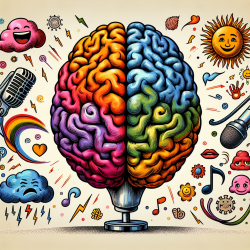Introduction
The cerebellum, traditionally known for its role in motor control, has recently been spotlighted for its involvement in affect regulation. The research article, "A Missing Link in Affect Regulation: The Cerebellum," explores this connection, presenting a model that could revolutionize our understanding of mood disorders. This blog post will delve into the implications of these findings for practitioners, particularly those working with children, and encourage further research in this area.
The Cerebellum's Expanded Role
Historically, the cerebellum was viewed as a structure dedicated to fine-tuning motor activities. However, recent studies, including the one by Frazier et al., highlight its significant role in non-motor functions, particularly in affect regulation. The cerebellum's extensive neural connections suggest its influence extends to emotional and cognitive processes, challenging the traditional view.
Key Findings and Their Implications
The research indicates that cerebellar damage can lead to affective disturbances such as depression, bipolar disorder, and pseudobulbar affect. These findings are crucial for practitioners as they suggest that cerebellar health could be a significant factor in emotional and behavioral regulation.
- Pseudobulbar Affect: Characterized by involuntary emotional expression, this condition highlights the cerebellum's role in emotional modulation.
- Manic and Bipolar Symptoms: The cerebellum's involvement in mood regulation suggests that its dysfunction could contribute to mood disorders, providing a new avenue for diagnosis and treatment.
- Depressive Symptoms: The cerebellum's connection to mood regulation implies that cerebellar interventions could benefit those with depression.
Practical Applications for Practitioners
Understanding the cerebellum's role in affect regulation can enhance therapeutic strategies. Practitioners can consider cerebellar health when assessing mood disorders, potentially incorporating cerebellar-focused interventions. For children, this could mean early identification of cerebellar dysfunction, leading to timely and targeted interventions that could improve emotional and behavioral outcomes.
Encouraging Further Research
The findings from this study open numerous avenues for further research. Investigating the cerebellum's role in affect regulation could lead to novel therapeutic approaches for mood disorders. Researchers are encouraged to explore cerebellar interventions and their impact on emotional and cognitive health, particularly in children.
Conclusion
The cerebellum's role in affect regulation is a promising area of research with significant implications for practitioners. By integrating these findings into practice, professionals can enhance their diagnostic and therapeutic strategies, ultimately improving outcomes for children and adults alike.
To read the original research paper, please follow this link: A Missing Link in Affect Regulation: The Cerebellum.










